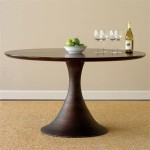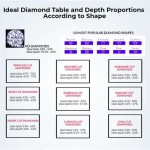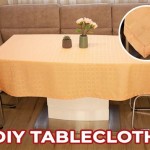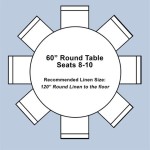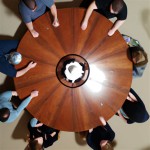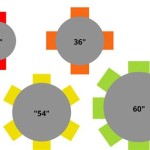What Size Tablecloth is Needed for a 5 ft Round Table?
Determining the appropriate tablecloth size for a 5 ft (60-inch) round table involves more than simply matching the diameter. The desired aesthetic, the formality of the event, and the functionality of the tablecloth all play crucial roles in the selection process. Understanding concepts such as "drop" and different drop lengths is essential for achieving the perfect look and ensuring the tablecloth serves its intended purpose.
A tablecloth performs several functions beyond merely covering a table. It protects the table surface from spills, scratches, and heat damage. It enhances the table's appearance, adding color, texture, and style to the overall décor. Furthermore, a tablecloth can create a specific ambiance, ranging from casual and relaxed to formal and elegant. Consequently, careful consideration must be given to the tablecloth size to effectively achieve these objectives.
The primary factor in determining the correct tablecloth size is the "drop." The drop refers to the length of the tablecloth that hangs over the edge of the table. Different drop lengths create different visual effects and serve different practical purposes. The choice of drop length typically depends on the formality of the event and the desired aesthetic.
Measuring the table accurately is crucial before selecting a tablecloth. Measure the diameter of the round table. In this case, the diameter is provided as 5 ft or 60 inches. This measurement serves as the foundation for calculating the required tablecloth size, taking into account the desired drop length.
Understanding Different Tablecloth Drop Lengths
Various tablecloth drop lengths are available, each suited for different occasions and styles. Common options include lap-length, mid-length, and full-length drops. Each offers a distinct look and level of protection.
Lap-Length Drop (6-12 inches): A lap-length drop, typically ranging from 6 to 12 inches, is considered a casual and practical choice. This length is suitable for everyday use, informal gatherings, and situations where ease of movement around the table is prioritized. The shorter drop prevents the tablecloth from interfering with guests' legs and makes it easy to clean up spills quickly. For a 60-inch round table, a lap-length drop of 6 inches would require a tablecloth with a diameter of 72 inches (60 inches + 6 inches + 6 inches). Tablecloths with a 72-inch to 84-inch diameter can therefore be considered to achieve this length on top of a 5 ft round table.
Mid-Length Drop (12-18 inches): A mid-length drop, ranging from 12 to 18 inches, offers a balance between formality and practicality. It is suitable for slightly more formal occasions, such as luncheons, dinner parties, and holiday gatherings. This length provides a more elegant appearance than a lap-length drop but still allows for comfortable movement around the table. For a 60-inch round table, a mid-length drop of 15 inches, for instance, would require a tablecloth with a diameter of 90 inches (60 inches + 15 inches + 15 inches). Consider cloths ranging from 84-inch to 96-inch diameter.
Full-Length Drop (28-30 inches): A full-length drop, typically ranging from 28 to 30 inches, creates a formal and elegant aesthetic. The tablecloth extends to the floor, creating a dramatic and sophisticated look. This length is ideal for weddings, banquets, and other formal events. However, it is important to note that a full-length drop can be less practical for everyday use, as it can be easily snagged or stepped on. Furthermore, it can restrict movement around the table. For a 60-inch round table, a full-length drop of 30 inches would require a tablecloth with a diameter of 120 inches (60 inches + 30 inches + 30 inches). These types of tablecloths are also known as banquet tablecloths. If used outdoors, keep in mind that these longer drops may be more susceptible to catching wind.
Material and its Influence on Tablecloth Drape
The material of the tablecloth significantly impacts its drape and overall appearance. Different fabrics have varying weights, textures, and stiffness, all of which influence how the tablecloth hangs and falls. Common tablecloth materials include linen, cotton, polyester, and blends of these fibers. Each material offers unique advantages and disadvantages in terms of durability, maintenance, and aesthetic appeal.
Linen: Linen is a natural fiber known for its elegant drape and timeless appeal. It has a slightly heavier weight than cotton and creases easily, adding to its character. Linen tablecloths are often chosen for formal occasions and special events. However, linen requires more care than other materials, as it is prone to wrinkling and may require ironing. When determining table cloth sizing, linen's tendency to shrink after the first wash also needs to be taken into consideration.
Cotton: Cotton is a versatile and affordable option that is suitable for both casual and formal settings. It is soft, absorbent, and easy to care for. Cotton tablecloths are available in a wide range of colors and patterns. While cotton is more wrinkle-resistant than linen, it can still benefit from ironing. It is a moderately weighted material that drapes well over tables of any size.
Polyester: Polyester is a synthetic fabric known for its durability, wrinkle resistance, and stain resistance. Polyester tablecloths are a practical choice for everyday use and high-traffic events. They are easy to clean and require minimal ironing. Polyester fabrics are lightweight and come in many different quality standards.
Blends: Blended fabrics combine the benefits of two or more materials. For example, a cotton-polyester blend offers the softness of cotton and the durability of polyester. Blended tablecloths provide a balance of aesthetic appeal and practicality. Depending on the primary fabric, these table cloths tend to offer more advantages.
The weight and stiffness of the chosen material will influence how the tablecloth drapes. Heavier fabrics, such as linen, tend to have a more graceful and elegant drape, while lighter fabrics, such as polyester, may require more attention to ensure they hang evenly. When selecting a tablecloth material, it is essential to consider the desired aesthetic, the level of formality, and the ease of maintenance.
Practical Considerations for Tablecloth Selection
Beyond aesthetics, several practical considerations should influence the choice of tablecloth size and material. These include the frequency of use, the potential for spills, and the ease of cleaning. Selecting a tablecloth that meets these practical needs ensures its longevity and functionality.
Frequency of Use: For everyday use, a durable and easy-to-clean tablecloth is essential. Materials like polyester or cotton-polyester blends are ideal for frequent use, as they are resistant to stains and wrinkles and can be easily laundered. A lap-length or mid-length drop is also practical for everyday use, as it prevents the tablecloth from dragging on the floor and becoming soiled. For seldom-used tables, the material may not matter as much as the aesthetics.
Potential for Spills: If spills are likely, a stain-resistant tablecloth is a must. Polyester and vinyl tablecloths are naturally stain-resistant, while other materials can be treated with stain-resistant finishes. Darker colors and patterns can also help to camouflage stains. In addition, consider a tablecloth with a water-repellent coating to prevent liquids from soaking through. Thicker material options will likely provide higher resistance to spills damaging the table surface.
Ease of Cleaning: The ease of cleaning is another essential consideration. Machine-washable and dryer-safe tablecloths are the most convenient option. However, some materials, such as linen, may require special care, such as hand washing or professional laundering. Always follow the manufacturer's instructions when cleaning a tablecloth to ensure its longevity. For easier clean up, consider purchasing disposable tablecloths. These are typically made of plastic and provide a sanitary barrier between messy situations and surfaces.
Consider the table's intended use when weighing these practical considerations. A dining table used for daily meals will require a more durable and easy-to-clean tablecloth than a decorative table used for occasional displays. By carefully considering these practical factors, one can select a tablecloth that meets their needs and provides years of reliable service.
Ultimately, choosing the right tablecloth size for a 5 ft round table involves balancing aesthetic considerations with practical needs. By understanding the different drop lengths, material options, and practical considerations, one can select a tablecloth that enhances the table's appearance, protects its surface, and adds to the overall ambiance of the space.

Round Tablecloth Size Guide Textile Town

Tablecloth Size Guide Table Linen Hire Tips Plato

120 Inch Polyester Round Tablecloth Black Table Cloth

5ft 6 168cm Round Table A Place Setting

Table Hire Guide Be Event

Let S Talk Linens The Ultimate Guide To Table Linen Sizes Party Al Ltd Pink Hippo Blog

Tablecloth Size Guide For Square Rectangular Round Tables

Petals Table Cloth Taffetta Petal Tablecloth Round Runners

Let S Talk Linens The Ultimate Guide To Table Linen Sizes Party Al Ltd Pink Hippo Blog

Getting The Right Tablecloth Measurements Cv Linens
Related Posts

